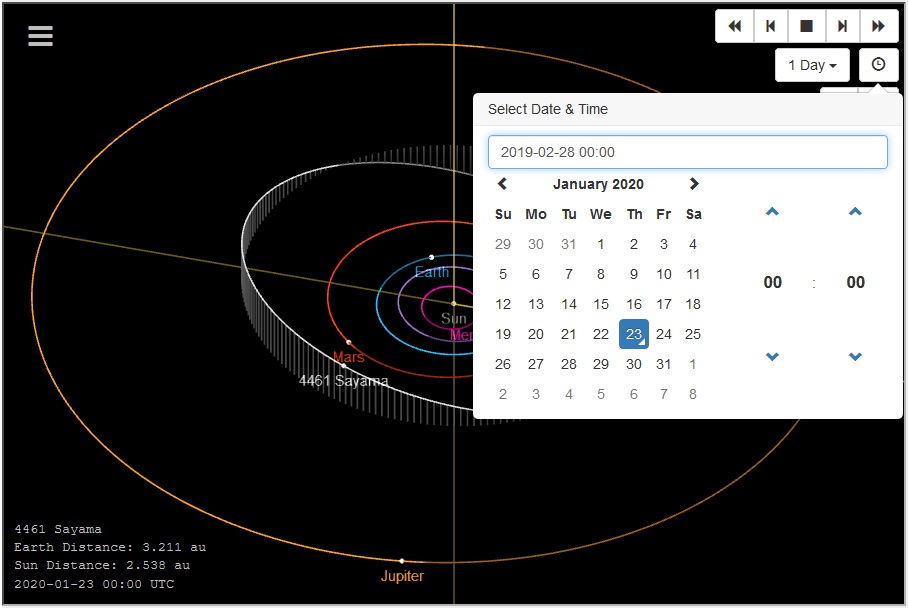4h40 exposure (L:56x300s)
Acquired on the 28th of February 2019 with Samyang 135mm

Several asteroids in the field of Markarian chain. Samyang 135mm F/2 at F/2.8, QHY163m gain=100
This article depicts a method to identify asteroids on personal photos. This method uses Aladin Desktop software from Strasbourg astronomical Data Center and SkyBot (Sky Body Tracker) from IMCCE (Institut de Mecanique celeste et de calcul des ephemerides) / Paris Observatory. The last part of this article explains how to obtain the orbit as well as the mass of the asteroid using JPL Small-Body Database Browser of NASA.
Prerequisite
This method requires numerous images acquired on several hours to clearly seeing mooving objects of the solar system and then being able to identify them.
Once obtained, images need to be stacked using a mode that preserves information of every images. For users of DeepskyStacker, select the “Maximum” option in the “Stacking Parameters”.
Once the stacked image obtained, try to detect unusual elements among these:
- Satellite or airplane traces (visible only on one image of the stack)
- Artifacts resulting of dithering (atypical pixel of your CCD or CMOS sensor replicated several times on the image)
- Cosmic rays (several pixels affected, visible only on one image of the stack)
- Asteroids and comets. Seen as small line segment (blurry for a comet), eventually interrupted in case a meridian flip occured during the acquisition. This break in the trajectory is generally a sign that you are observing a real object!
- Shooting star (visible only on one image of the stack)
In case of doubt with an unusual element, simply observe several images of the stack to verify this element is visible each time.
You detected a possible object? Please move to next part of this article to identify it!
Asteroid identification method
1. Open Aladin software. If not already installed, click here for download
2. Find star field corresponding to your image

3. Open server selector (“File”>”Open server selector”)

4. Click on “SkyBot”

5. Enter date and time in “Epoch” field and then click on “Submit”
- Target (ICRS, name): Select field of interest. If you already selected your field, AD and DEC are already mentioned
- Radius: SkyBot will provide data for all target in this radius
- Epoch: Date and time. To be enterer respecting the format YYYY-MM-DDThh:mm:ss
- Observer location: Do not change the value
- Search for: Select “Asteroids and Comets”
- Max. uncertainty: Do not change the value
- Display filter: Select “Arrow of motion”. This will provide a clear indication of the objetc motion
7. Come back now on your own image and check the nature of the objects you identified in the beginning of this article

Identification of Sayama asteroid. Position and trajectory match perfectly with data provided by SkyBot! And magnitude of this asteroid (15.9) is far below the highest magnitude reached on this image (18.5). Nearby, 2005 EW95 asteroid exceeds magnitude 18.5 and is simply not visible on the image.
Obtain orbit, mass and much more
1. To obtain the orbit of the object as well as its diameter, go on the JPL Small-Body Database Browser website and enter object name:
2. Diameter, rotation period and several others parameters are given below. Click on “show orbit diagram” to display orbit
3. Orbit of the current day is displayed. Click on the clock icon to adjust date and time
4. Enter date and time and press return
5. Adjust zoom at your desire using mouse wheel and that’s it!
About Aladin
Aladin is a free interactive sky atlas developped by the Strasbourg astronomical Data Center – Strasbourg Observatory – France.
Aladin displays photographies as well as full sky surveys. It allows superimposing entries from astronomical catalogues and databases, such as Simbad, VizieR services and other archives for all known astronomical objects in a given field of view.
This software is a research tool and a huge source of information allowing astronomical objects identification.
Aladin web page: https://aladin.u-strasbg.fr/AladinDesktop/
About SkyBoT
SkyBoT (Sky Body Tracker) is a service developped and provided by IMCCE (Institut de Mecanique celeste et de calcul des ephemerides) / Paris Observatory. This service aims at proving to astronomers a tool to prepare and analyze solar system objects observations. Its main usage concerns the seek and identification of solar system objects in astronomical images. Further information about SkyBot can be found on IMCCE website: http://vo.imcce.fr/webservices/skybot/.
About JPL Small-Body Database Browser
JPL Small-Body Database Browser is a service proposed by NASA/JPL. It provides data for all known asteroids and many comets. Available data include:
- Orbital elements
- Orbit diagrams
- Physical parameters
- Discovery circumstances
Newly discovered objects and their orbits are added on a daily basis. Discovery circumstances are updated on a roughly monthly interval. Physical parameters, other than magnitude parameters, are updated on a less frequent basis.
JPL Small-Body Database Browser web page: https://ssd.jpl.nasa.gov/sbdb.cgi











